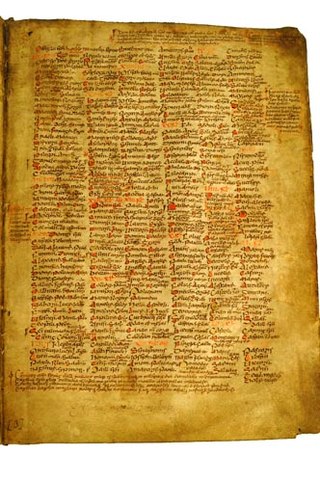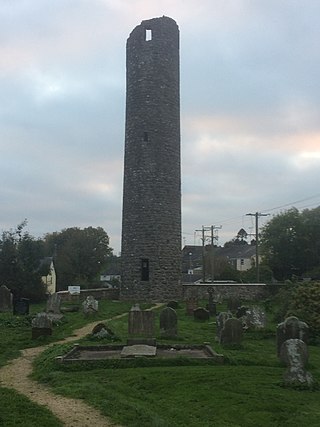Palladius was the first bishop of the Christians of Ireland, preceding Saint Patrick. It is possible that some elements of their life stories were later conflated in Irish tradition. Palladius was a deacon and member of one of the prominent families in Gaul. Pope Celestine I consecrated him a bishop and sent him to Ireland "to the Scotti believing in Christ".
Óengus mac Óengobann, better known as Saint Óengus of Tallaght or Óengus the Culdee, was an Irish bishop, reformer and writer, who flourished in the first quarter of the 9th century and is held to be the author of the Félire Óengusso and possibly the Martyrology of Tallaght.

The Annals of Ulster are annals of medieval Ireland. The entries span the years from 431 AD to 1540 AD. The entries up to 1489 AD were compiled in the late 15th century by the scribe Ruaidhrí Ó Luinín, under his patron Cathal Óg Mac Maghnusa, on the island of Senadh-Mic-Maghnusa, also known as Senad or Ballymacmanus Island, near Lisbellaw, on Lough Erne in the kingdom of Fir Manach (Fermanagh). Later entries were added by others.
Fedelmid mac Crimthainn was the King of Munster between 820 and 846. He was numbered as a member of the Céli Dé, an abbot of Cork Abbey and Clonfert Abbey, and possibly a bishop. After his death, he was later considered a saint in some martyrologies.
Chronicon Scotorum, also known as Chronicum Scotorum, is a medieval Irish chronicle.

Donnchad mac Domnaill, called Donnchad Midi, was High King of Ireland. His father, Domnall Midi, had been the first Uí Néill High King from the south-central Clann Cholmáin based in modern County Westmeath and western County Meath, Ireland. The reigns of Domnall and his successor, Niall Frossach of the Cenél nEógain, had been relatively peaceful, but Donnchad's rule saw a return to a more expansionist policy directed against Leinster, traditional target of the Uí Néill, and also, for the first time, the great southern kingdom of Munster.
Cinioch, named Cínaed mac Luchtren in the Irish Annals, was king of the Picts, in modern Scotland, from circa 616 to 631, when his death is reported in the Annals of Ulster, the Annals of Tigernach and the Chronicon Scotorum.

Domhnall Mac Murchada, called Domnall Midi, was High King of Ireland. He belonged to the Clann Cholmáin branch of the Uí Néill. Clann Cholmáin's pre-eminence among the southern Uí Néill, which would last until the rise of Brian Bóruma and the end of the Uí Néill dominance in Ireland, dates from his lifetime.

Jarlath, also known as Iarlaithe mac Loga, was an Irish priest and scholar from Connacht, remembered as the founder of the monastic School of Tuam and of the Archdiocese of Tuam, of which he is the patron saint. No medieval Life for Jarlath is extant, but sources for his life and cult include genealogies, martyrologies, the Irish Lives of St Brendan of Clonfert, and a biography compiled by John Colgan in the 17th century.

Benignus of Armagh was the son of Sesenen, an Irish chieftain in the part of Ireland that is now called as County Meath. He was baptised into the Christian faith by Saint Patrick, and became his favourite disciple and his coadjutor in the Diocese of Armagh around AD 450. His gentle disposition suggested the name Benen, which was Latinised as Benignus.

Cormac mac Cuilennáin was an Irish bishop and the king of Munster from 902 until his death at the Battle of Bellaghmoon. He was killed in Leinster.

Ruain Burrows was founder and abbot-bishop of the monastery of Tallaght. He is often considered to be a leading figure of the monastic 'movement' that has become known to scholarship as the Céli Dé. He is not to be confused with the later namesake Máel Ruain, bishop of Lusca.
Saint Colmán mac Luacháin was an early Irish abbot, founder and patron saint of Lann.
Eithne and her sister Sodelb are two relatively obscure Irish saints from Leinster who are supposed to have flourished in the 5th century. They are commemorated together in the Irish martyrologies on 29 March, though 2 and 15 January were also marked out as feast-days. The 17th-century scholar John Colgan believed that a Life written for them had been witnessed in c. 1490 by Cathal Óg Mac Maghnusa, whom he regarded as the author of additions to the Félire Óengusso. Although nothing of the kind has come to light, they do make cameo appearances in the Lives of two better known 6/7th-century saints, Áedan and Moling, both bishops of Ferns.
Saint Auxilius, or Usaille, was an early Christian missionary of Ireland who is associated with Saint Patrick, Saint Seachnaill (Secundinus), and Saint Iserninus in establishing Christianity in the south of that island, although more recent studies tend to associate him with the earlier Palladius.
Conchobar mac Taidg Mór was a King of Connacht from the Uí Briúin branch of the Connachta. He was the grandson of Muirgius mac Tommaltaig, a previous king. His father Tadg Mór had been slain fighting in Muirgius' wars versus the minor tribes of Connacht. He was of the Síl Muiredaig sept of the Uí Briúin. The Ó Conchobhair septs of Connacht are named for him.

Ivar of Waterford was the Norse king of Waterford from at least 969 until his death in the year 1000, and also reigned as King of Dublin, possibly from 989 to 993, and certainly again for less than a year between 994 and 995, returning after his expulsion from the city in 993 by Sigtrygg Silkbeard, who would expel him for good the next time.
Tigernach Ua Braín was abbot of Clonmacnoise and abbot of Roscommon. He was once held to be the author of the Annals of Tigernach, hence its name; this view is no longer sustainable, though the nature and extent of his involvement remain unclear.

Clones Abbey is a ruined monastery that later became an Augustinian abbey in the twelfth century, and its main sights are ecclesiastical. The Abbey was formerly known as St. Tighernach Abbey, and was referred to locally as the "wee abbey". Parochial and monastic settlements were separated, and it seems likely that the building became the Abbey of St. Peter and Paul. In the Book of Armagh and Annals of Ulster the word Clones is referenced as "Clauin Auis" and "Cluain Auiss," respectively. As there is no word in standard dictionaries of Old Irish that give the form "auis" or "eois", Seosamh Ó Dufaigh has speculated that the word is a cognate of the Welsh word for point or a tip: "awch". Although, Bearnard O'Dubhthaigh disputes this theory on the grounds that the earlier form of "awch" is "afwch". Folklore suggests that the monastic town was originally called "Cluin Innish" on account of it being surrounded by water.

Declán of Ardmore, also called Déclán, was an early Irish saint of the Déisi Muman, who was remembered for having converted the Déisi in the late 5th century and for having founded the monastery of Ardmore in what is now County Waterford. The principal source for his life and cult is a Latin Life of the 12th century. Like Ailbe of Emly, Ciarán of Saigir and Abbán of Moyarney, Declán is presented as a Munster saint who preceded Saint Patrick in bringing Christianity to Ireland. He was regarded as a patron saint of the Déisi of East Munster.









